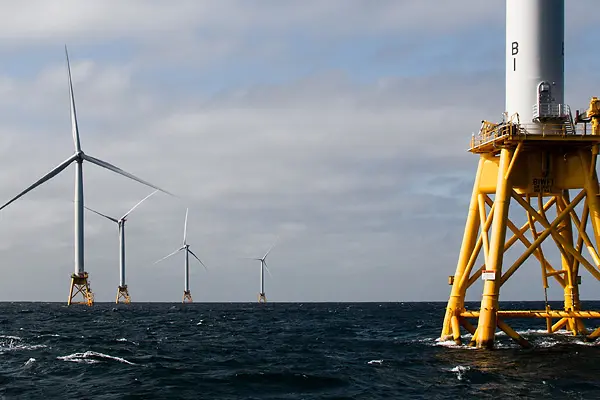 Image by Gary Norton/DOE
Image by Gary Norton/DOE
UMass Lowell researchers are collaborating with academic and industry partners on a new consortium, called the Academic Center for Reliability and Resilience of Offshore Wind, or ARROW, which aims to make offshore wind energy reliable, resilient and equitable across the country.
UMass Lowell researchers are gearing up to expand their efforts targeting offshore wind energy as part of a collaborative project with UMass Amherst, UMass Dartmouth and other partners.
The research team, led by UMass Amherst, has won nearly $12 million in funding – including a $4.75 million grant from the U.S. Department of Energy (DOE), with a matching commitment of $4.75 million from the Massachusetts Clean Energy Center (MassCEC) – to establish the Academic Center for Reliability and Resilience of Offshore Wind (ARROW).
A national center of excellence, ARROW will accelerate research and the deployment and scale-up of domestic offshore wind energy. The five-year project also aims to develop a pipeline of highly skilled workers to meet the needs of industry, as well as to establish U.S. global leadership in offshore wind energy education.
The state of Maryland is also contributing $1 million through the Maryland Energy Administration. Other institutions, including Johns Hopkins University, Clemson University, Morgan State University, Northeastern University and the University of Puerto Rico at Mayagüez, are contributing $1.4 million for a total budget of $11.9 million. Other partners include the Argonne National Laboratory, the National Renewable Energy Laboratory, the Pacific Northwest National Laboratory and dozens of other companies and organizations.

Mechanical Engineering Prof. Christopher Niezrecki is the principal investigator for UMass Lowell in the ARROW consortium.
“What is unique about this project is that this is the first time that I am aware of that UMass Amherst, UMass Lowell and UMass Dartmouth are collaborating with several other universities on this important initiative,” says Niezrecki, who directs WindSTAR, an industry-university cooperative research center funded by the National Science Foundation.
“UMass Lowell has proven it’s a leader in spurring clean energy innovation, entrepreneurship and workforce development,” says Emily Reichert, CEO of MassCEC. “The university will be a vital partner in the Massachusetts-led ARROW consortium, helping us accelerate this climate-critical industry and create good jobs for current and future generations.”
The Answer Is Blowin’ in the Wind
According to the DOE, the country’s offshore wind resources are abundant, strong and consistent. Its data suggests that there are potentially more than 4,000 gigawatts (GW) of capacity, or 13,500 terawatt-hours of generation, per year in federal waters of the United States as well as the Great Lakes.
“While not all of this resource potential will realistically be developed, the magnitude – approximately 3 times the annual electricity consumption in the United States – represents a substantial opportunity to generate electricity near coastal, high-density population centers,” the agency states.
Here in Massachusetts, construction is currently underway for Vineyard Wind 1, which will become the nation’s first utility-scale offshore wind energy project. Situated 15 miles south of Martha’s Vineyard and Nantucket, the wind farm will consist of an array of 62 turbines that will “generate 800 megawatts of electricity and power over 400,000 homes, while reducing carbon emissions by over 1.6 million tons per year,” according to the project’s website.
The ARROW consortium will help foster the interdisciplinary research, education and training needed to achieve the U.S. federal government’s goal of deploying 30 GW of new offshore wind energy by 2030, which is intended to support 77,000 jobs, power 10 million homes and cut 78 million metric tons in carbon emissions.
“As far as wind energy resource goes, the New England coast, especially Massachusetts, probably has the best offshore wind potential in the country,” says Niezrecki. “It is one of the most reliable places to harness wind energy, so it’s extremely important for the state to be able to tap into this clean, renewable and practically limitless resource.”
Niezrecki notes that the waters off Massachusetts are shallower in depth (less than 60 meters) compared with other sites along the East Coast and West Coast.
“This makes it easier to build and install wind turbine platforms with fixed-bottom foundations on the state’s continental shelf,” he says. “On the West Coast, you have very deep waters, so you’ll need floating wind turbines, which are more complicated to build and not as well developed as fixed platforms.”
As a hub for technological research and academic training, ARROW plans to offer research opportunities to undergraduate and graduate students as well as a summer school for workforce development training involving key aspects of offshore wind energy, such as the development of rotor blades, tower structures, drive trains and foundations, and the manufacturing process, supply chains and blade recycling.
“For example, if a faculty member has a research project under this center, the professor can hire undergrad students so they can work together on the project,” Niezrecki says.
ARROW will also help facilitate engagement with local communities as part of its public outreach efforts, he says.
“This involves educating the public on the benefits of offshore wind energy as well as addressing any concerns residents might have with regard to the impact on the environment, people, wildlife, bird migration and fisheries, mitigating climate change, reducing carbon footprint and so forth,” says Niezrecki.
